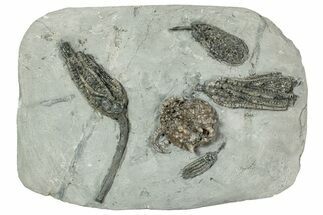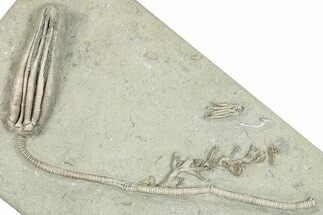This Specimen has been sold.
Cyathocrinus & Platycrinites Crinoid Association - Indiana
This is a cool association of two different species of crinoids, Cyathocrinus iowensis & Platycrinites brevinodus. The quality of preparation on this fossil is exquisite - using skillful air-abrasion techniques under a stereo microscope.
It is believed that crinoids from the Ramp Creek Limestone were buried in sediment from nearby deltas during storms. The resulting siltstone deposits are soft enough that fossils can be extracted in exquisite, three-dimensional relief.
Crinoids are commonly known as sea lilies, though they are animals, not plants. They are echinoderms related to starfish, sea urchins, and brittle stars. They attached themselves to the sea floor and had feathery, tentacle-like appendages which they used to capture particles of food. First appearing in the Ordovician period, 488 million years ago, they still survive to this day in deep water.
It is believed that crinoids from the Ramp Creek Limestone were buried in sediment from nearby deltas during storms. The resulting siltstone deposits are soft enough that fossils can be extracted in exquisite, three-dimensional relief.
Crinoids are commonly known as sea lilies, though they are animals, not plants. They are echinoderms related to starfish, sea urchins, and brittle stars. They attached themselves to the sea floor and had feathery, tentacle-like appendages which they used to capture particles of food. First appearing in the Ordovician period, 488 million years ago, they still survive to this day in deep water.
SPECIES
Cyathocrinus iowensis & Platycrinites brevinodus
LOCATION
Montgomery County, Indiana
FORMATION
Ramp Creek Limestone
SIZE
Both crowns about 1"
CATEGORY
SUB CATEGORY
ITEM
#29414
We guarantee the authenticity of all of our specimens.
 Reviews
Reviews












